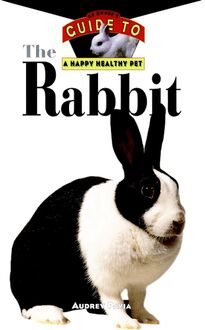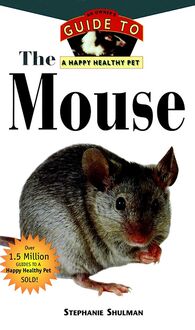-
 Univers
Univers
-
 Ebooks
Ebooks
-
 Livres audio
Livres audio
-
 Presse
Presse
-
 Podcasts
Podcasts
-
 BD
BD
-
 Documents
Documents
-
- Cours
- Révisions
- Ressources pédagogiques
- Sciences de l’éducation
- Manuels scolaires
- Langues
- Travaux de classe
- Annales de BEP
- Etudes supérieures
- Maternelle et primaire
- Fiches de lecture
- Orientation scolaire
- Méthodologie
- Corrigés de devoir
- Annales d’examens et concours
- Annales du bac
- Annales du brevet
- Rapports de stage
La lecture à portée de main
Vous pourrez modifier la taille du texte de cet ouvrage
Découvre YouScribe en t'inscrivant gratuitement
Je m'inscrisDécouvre YouScribe en t'inscrivant gratuitement
Je m'inscrisEn savoir plus
Vous pourrez modifier la taille du texte de cet ouvrage
En savoir plus

Description
PART ONE: Welcome to the World of the Hedgehog.
1. What Is a Hedgehog?
2. Hedgehogs as Pets.
3. Choosing and Preparing for Your Hedgehog.
PART TWO: Living with a Hedgehog.
4. Bringing Your Hedgehog Home.
5. Grooming Your Hedgehog.
6. Hedgehog Nutrition.
7. Keeping Your Hedgehog Healthy.
PART THREE: Enjoying Your Hedgehog.
8. Socializing Your Hedgehog.
9. Fun with Your Hedgehog.
10. Hedgehog Folktales, Myths and Mysteries.
11. Legal Issues of Hedgehog Ownership.
PART FOUR: Beyond the Basics.
12. Recommended Reading.
13. Resources.
Sujets
Informations
| Publié par | Turner Publishing Company |
| Date de parution | 05 mai 2008 |
| Nombre de lectures | 0 |
| EAN13 | 9780470368985 |
| Langue | English |
| Poids de l'ouvrage | 1 Mo |
Informations légales : prix de location à la page 0,0700€. Cette information est donnée uniquement à titre indicatif conformément à la législation en vigueur.
Extrait
The
Hedgehog
Howell Book House
Wiley Publishing, Inc.
Copyright 1997, 2002 by Wiley Publishing, Inc. All rights reserved
Howell Book House
Published by Wiley Publishing, Inc., Hoboken, NJ
Published simultaneously in Canada
No part of this publication may be reproduced, stored in a retrieval system, or transmitted in any form or by any means, electronic, mechanical, photocopying, recording, scanning, or otherwise, except as permitted under Section 107 or 108 of the 1976 United States Copyright Act, without either the prior written permission of the Publisher, or authorization through payment of the appropriate per-copy fee to the Copyright Clearance Center, 222 Rosewood Drive, Danvers, MA 01923, (978) 750-8400, fax (978) 646-8600, or on the web at www.copyright.com . Requests to the Publisher for permission should be addressed to the Legal Department, Wiley Publishing, Inc., 10475 Crosspoint Blvd., Indianapolis, IN 46256, (317) 572-3447, fax (317) 572-4447.
Limit of Liability/Disclaimer of Warranty: While the publisher and the author have used their best efforts in preparing this book, they make no representations or warranties with respect to the accuracy or completeness of the contents of this book and specifically disclaim any implied warranties of merchantability or fitness for a particular purpose. No warranty may be created or extended by sales representatives or written sales materials. The advice and strategies contained herein may not be suitable for your situation. You should consult with a professional where appropriate. Neither the publisher nor the author shall be liable for any loss of profit or any other commercial damages, including but not limited to special, incidental, consequential, or other damages.
For general information about our other products and services, please contact our Customer Care Department within the United States at (800) 762-2974, outside the United States at (317) 572-3993 or fax (317) 572-4002.
Library of Congress Cataloging-in-Publication data
Wrobel, Dawn.
The hedgehog: an owner s guide to happy, healthy pet/by Dawn Wrobel with Susan A.
Brown, DVM.
p.cm.
Includes bibliographical references
ISBN 0-87605-501-3
1. Hedgehogs as pets. I. Tide. II. Series
SF459.H43W76 1996, 2002
636.9 332-dc21 96-49686
CIP
Manufactured in the United States of America
10 9 8 7
Series Director: Kira Sexton
Book Design: Michele Laseau
Cover Design: Michael Freeland
Photography Editor: Richard Fox
Illustration: Jeff Yesh
Photography:
Cover photos by Renee Stockdale (front) and Jean Wentworth (back)
Joan Balzarini: 5, 6, 22, 26, 28, 36, 65, 70, 106, 113
Bob Mason: 25, 32, 40, 55, 57, 58, 59, 60, 64
John Shilling: 109
Renee Stockdale: 2-3, 7, 8, 9, 11, 12, 14, 17, 18, 19, 20, 21, 23, 24, 26, 27, 29, 31, 38-39, 41, 42, 44, 45, 46, 47, 54, 61, 62, 66, 67, 71, 74, 76, 78, 81, 82, 83, 88-89, 90, 91, 92, 95, 96, 97, 99, 103, 104, 107, 108, 110, 115, 117
Jean Wentworth: 53, 100, 119
Dawn Wrobel: 24, 30, 37, 50, 56, 68, 98, 101, 111
Page creation by: Wiley Indianapolis Composition Services
Contents
part one
Welcome to the World of the Hedgehog
1 What Is a Hedgehog?
2 Hedgehogs as Pets
3 Choosing and Preparing for Your Hedgehog
part two
Living with a Hedgehog
4 Bringing Your Hedgehog Home
5 Grooming Your Hedgehog
6 Hedgehog Nutrition
7 Keeping Your Hedgehog Healthy
part three
Enjoying Your Hedgehog
8 Socializing Your Hedgehog
9 Fun with Your Hedgehog
10 Hedgehog Folktales, Myths and Mysteries
11 Legal Issues of Hedgehog Ownership
part four
Beyond the Basics
12 Resources
part one
chapter 1
What Is a Hedgehog?
A scientist would say that a hedgehog belongs to the class known as Mammals. Their subclass, Eutheria, includes the higher mammals as opposed to marsupials or egg-laying mammals. Within the subclass Eutheria, hedgehogs belong to the order Insectivora, which also includes moles, tenrecs and shrews. This order contains the earliest examples of placental mammals-mammals whose young are retained within the mother s uterus and nourished via a placenta before birth. The hedgehog family is Erinaceidae, which also includes moon rats, gymnures and shrew hedgehogs. This family is the most primitive living insectivore family. Fossils of hedgehog ancestors date back to the time of the dinosaurs. Finally, the subfamily or genus that includes only spiny hedgehogs is Erinaceinae. Some authorities prefer to place them in the genus Atelerix, and it is this name that you will see most frequently in books about African Pygmy hedgehogs.
Origins of the African Pygmy Hedgehog
We know that hedgehogs have been inhabiting the earth as long as the dinosaurs, but in order to understand the needs of the hedgehog as a pet today, it is important to learn something about the hedgehog s natural habitat. The African hedgehog, commonly referred to as the African Pygmy hedgehog, is found across a large area of hot, dry land stretching from southern Europe all the way to South Africa, and from Senegal to northern Somalia, thus covering most of Africa. It is a creature of the savanna, an area of grassland interspersed with thick brush and occasional stands of trees. The territory of a single hedgehog is a circle with a radius of about 650 to 1,000 feet around its burrow. This territory may be even larger during periods when food is scarce.
This modern hedgehog, like most mammals, enjoys some playtime.
E VOLUTIONARY L INK TO H UMANS ?
Although hedgehogs are very primitive mammals and their development diverged from that of Homo Sapiens millennia ago, there is an interesting connection between the two. Researchers at two universities have discovered that the blood of both the European and African hedgehogs contains a lipoprotein identical to one of those found in human blood. This lipoprotein contributes to the formation of clots that cause heart attacks. In the past, this particular lipoprotein was only found in humans and a few nonhuman primates. Research is presently being conducted and our prickly little friends may eventually contribute a solution to a human health problem.
A close-up of hedgehog quills resembles a stack of finely packed needles.
Hedgehog Appearance
Knowledge of the origins of the hedgehog may be useful in understanding how hedgehogs can be studied in our present-day environment. The pet owner will most likely encounter hedgehogs that come from one of the two major categories: the European hedgehog and the African hedgehog. The European hedgehog is the larger hedgehog of the two types. It may grow to 12 inches in length and 3 pounds in weight. Typically, both the fur and the quills are a chestnut brown color. European hedgehogs are a protected species throughout much of their range because they are unfortunately the victims of a dwindling natural habitat. These adult hedgehogs are especially valued by gardeners who often try to attract them to their gardens because they may consume up to one-third of their body weight in slugs, snails and insects in a single day. European hedgehogs are rarely seen in zoos or the pet trade in the United States and Canada.
The African hedgehog, in contrast to its European relatives, averages about 1 pound in weight and 6 to 9 inches in length. Weight range is from 11 to 20 ounces in healthy individuals. The normal color seen in these hedgehogs is a white or cream colored belly and face with white quills banded in black or brown. The exact scientific names vary depending on the reference work and they are most often referred to collectively as Atelerix albiventris, or the Pruner s hedgehog, in pet books. It is this charming little creature with the big name that is the focus of this book.
Because hedgehogs are naturally inquisitive, they are often depicted as whimsical figures in children s stories.
The face, legs and underside of the hedgehog are covered in soft fur that is usually white in color. The face may be masked in a darker color and the lower leg often exhibits darker coloring. The hedgehog s eyes are large, dark and bright in healthy animals. Its ears are typically shorter than the quills, and are rounded and covered with fine hairs. The hedgehog has five toes on the front feet and four on the back.
HEDGEHOG TERMS
Hedgehogs are part of the Mammal class, but come from the earliest living insectivore family, Erinaceidae. This family is part of the Insectivora order, which is included in the Eutheria subclass.
Male and female hedgehogs look basically the same in color and fur texture. If you are not sure what sex it is, there are a couple of easy ways to investigate. You will find that females have four to five sets of tiny nipples and the anal and vaginal openings are adjacent to each other, next to the -inch long tail. In males, the opening of the prepuce, which houses the penis, is in the middle of the lower abdomen.
A P RICKLY D EFENSE
The hedgehog is designed to thwart all but the most persistent predator. Quills are modified, hollowed hairs. They are typically agouti, or banded, with a white tip and base and a center band of black or brown. This mottled pattern acts as camouflage for the hedgehog so it can blend in with its surroundings. The spines or quills vary from to 1 inch on adult hedgehogs. The length and density of quills vary from one hedgehog to another. In addition, the hedgehog s strong muscles run in a circle around the body under its loose skin. This muscle pattern allows the hedgehog to draw its body into a tight ball with erect, crisscross quills for defense.
This African Pygmy hedgehog, rolled up into a ball, is protected by its quills.
C OLOR V ARIATIONS
Due to captive breeding, there is a great increase in the variety of quill colors that now exists. The foundation stock for domestic hedgehogs was initially of two predominant patterns. The hedgehogs commonly known as Pruner s hedgehogs had black and white quills, a dark mask an
-
 Univers
Univers
-
 Ebooks
Ebooks
-
 Livres audio
Livres audio
-
 Presse
Presse
-
 Podcasts
Podcasts
-
 BD
BD
-
 Documents
Documents
-
Jeunesse
-
Littérature
-
Ressources professionnelles
-
Santé et bien-être
-
Savoirs
-
Education
-
Loisirs et hobbies
-
Art, musique et cinéma
-
Actualité et débat de société
-
Jeunesse
-
Littérature
-
Ressources professionnelles
-
Santé et bien-être
-
Savoirs
-
Education
-
Loisirs et hobbies
-
Art, musique et cinéma
-
Actualité et débat de société
-
Actualités
-
Lifestyle
-
Presse jeunesse
-
Presse professionnelle
-
Pratique
-
Presse sportive
-
Presse internationale
-
Culture & Médias
-
Action et Aventures
-
Science-fiction et Fantasy
-
Société
-
Jeunesse
-
Littérature
-
Ressources professionnelles
-
Santé et bien-être
-
Savoirs
-
Education
-
Loisirs et hobbies
-
Art, musique et cinéma
-
Actualité et débat de société
- Cours
- Révisions
- Ressources pédagogiques
- Sciences de l’éducation
- Manuels scolaires
- Langues
- Travaux de classe
- Annales de BEP
- Etudes supérieures
- Maternelle et primaire
- Fiches de lecture
- Orientation scolaire
- Méthodologie
- Corrigés de devoir
- Annales d’examens et concours
- Annales du bac
- Annales du brevet
- Rapports de stage




















